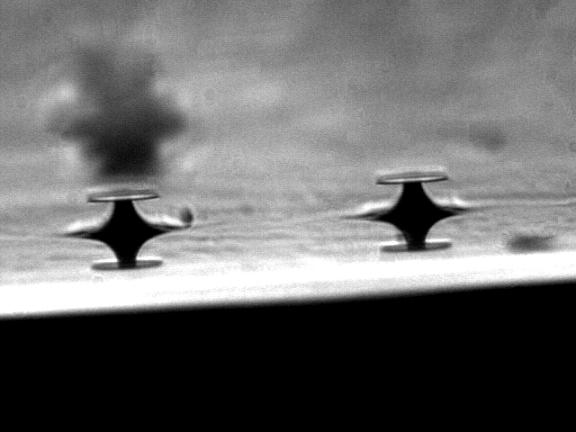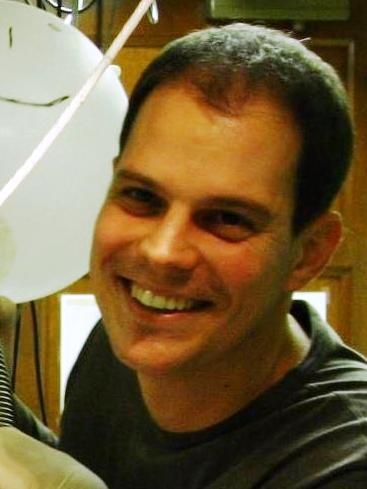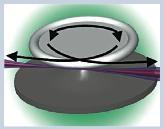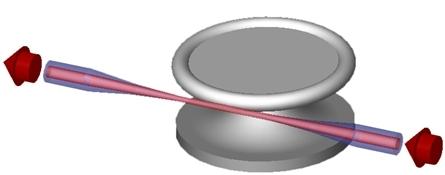The world of computing, scientists and experts assure us, will change completely the day quantum computers come into operation and replace today's "normal" computers. An interview with Dr. Barak Dayan from the Weizmann Institute, who is establishing a new laboratory at the institute for the development of practical quantum devices
By: Yaki Dayan*

The world of computing, scientists and experts assure us, will change completely the day quantum computers come into operation and replace today's "normal" computers. Our entire world, they predict, will change beyond recognition. But in the meantime, the devices that produce individual quantum gates (in a certain institute they managed to create an 8-bit gate based on quantum computing) are large and cumbersome and take up large rooms full of equipment.
Dr. Barak Dayan, a senior researcher from the Weizmann Institute of Science, hopes that the new laboratory he is establishing at the institute will be able to develop practical quantum devices, which could lead to a breakthrough in the application of quantum computing. Barak has something to rely on. Only a few months ago he returned from a three-year stay at one of the undisputed centers of quantum optics, at the prestigious campus of Caltech in Los Angeles, under the leadership of Professor Jeff Campbell. During his stay there, Barak was able to successfully complete two unique experiments that promoted the practical side of quantum optics and were even published in two of the most prestigious journals in the field - "Science" and "Nature".

"When I started my doctoral thesis at the Weizmann Institute of Science, I was looking to do something interesting, original, and of an applied nature," says Dayan. "It was clear to me that the direction was in quantum optics, which is the cutting edge of physics research these days. In the beginning, like any researcher, I came up with a lot of interesting but incorrect ideas, and when I already found interesting ideas that were also theoretically correct, I saw that they were no longer original - someone had done them before, and the name of Jeff Kimball from Caltech came up again and again as someone who had already implemented these ideas. It intrigued me - who is my competitor who catches me all the time?" The continuation was clear. Upon completion of his PhD, Dayan went to Caltech to continue research under the guidance of the legendary Jeff Kimball.
When I visited Barak at Caltech several years ago, I was greeted by green lawns and impressive and beautiful buildings. In the basement of one of the buildings, far from the light of day, Dayan and his team worked on the development of a silicon chip that allows interaction between a single atom and a single photon. Unlike physicists who study a flux of photons (light) or clusters of atoms, researchers in quantum optics like to play with a single atom or a single photon. Only a very limited number of laboratories managed to reach the technological achievement of "imprisoning" a single atom and bringing a single photon close to it in order to measure the interactions between them. Dayan's first development was a first-of-its-kind technological achievement in the world of using a single silicon device manufactured at Caltech that enables this interaction, and replaces large and cumbersome instruments. In the future, such a development could help miniaturize the technology of personal computers. This achievement earned Dayan and his team publication in the prestigious "Nightsher" magazine in 2006.

Dayan was determined to move on, and accomplish one more thing before returning back to Israel. The challenge is to allow one photon to influence another photon. Photons in nature do not affect each other. When we look at someone else, the continuum of light between us is not interrupted by light crossing it on its way. He tried something else - to use a single atom to transfer information from one photon to another and create a reaction between them. Tried - and succeeded. "We were able to create a situation where a single photon passing by an atom allows the atom to create a barrier that lasts several billionths of a second, which blocks the passage of a photon that follows it. This exposure appears for a very short period of time and allows for the first time for one photon to interfere with the passage of another photon, through the mediation of the atom." To illustrate the phenomenon to his colleagues, Dayan uses an example taken from a popular cartoon series. Remember that roadrunner, a bird that always evades the prairie fox - the cutie - that tries to catch it? In one of the videos, the fox draws a tunnel opening on the side of the mountain. When the Roadrunner arrives, he manages, to the fox's surprise, to go through the tunnel. The surprised fox also tries to go through the painting - and runs into a rock.
"Why is it good? What can be done with it?” IM asking. Dayan smiles. He is used to this question. Think of today's world of communication, based on the transmission of information using light in optical fibers. Today, when information from Tel Aviv to Haifa reaches the switch in Herzliya, electronic equipment has to regulate the traffic so that information from another place can join or pass through the same medium. Today, the world of communication is trying to achieve branding based entirely on optics. Think of the day, he enthuses, when the photons arriving from Tel Aviv will be able to signal to the other photons "Wait a minute, we are passing". The transition from the experimental laboratory to application in the media is still a long way off, but this breakthrough resulted in publication in an even more prestigious journal, "Science", in April 2008.

With the completion of the experiment, Dayan finally left Caltech and returned to the Weizmann Institute of Science to establish a laboratory in quantum optics that continues to research and try to develop more practical devices. Dayan believes that the number of laboratories in the world with similar technology is smaller than the fingers of one hand. "So what's the next direction?" . "For me, the next challenge is to find a practical way to discover that a photon has passed here, without destroying it," Dayan answers. Today, we know that a photon passed by stopping it. What is it similar to? Let's put a concrete wall in the middle of the road, and when a car collides with it and crashes, we'll say - look, we found out that a car passed here. Today we know that light passes by blocking the photons and absorbing the energy that is emitted when they stop. "I know what I want to discover, but I don't yet know how to do it," concludes Dayan, "but when we manage to develop it, it will have fascinating applications."
Written as part of the "Science in Communication" course at the Technion

12 תגובות
; o)
Answers:
To Michael's comment from comment 9:
First, such a measurement is called a QND measurement and of course I did not invent the idea (which has even already been applied in RF frequencies, but not in optics). I hope (but I could certainly be wrong) that the effect from the last experiment can be used to move in this direction, and we hope that my students and I will succeed in doing something before anyone else in the world succeeds.
And it is true - even in such a discovery of a photon (without its absorption) something in the photon will change - its phase. More precisely, since I know how many photons there are (for example, exactly 1 or exactly 2) then the phase becomes unknown, which is perfectly fine and that's how it should be in this quantum state (called the FOCK STATE).
In the experiment, the two slits can still see interference lines, if the photon is detected before the two slits (because then the phase is indeed unknown - but it is the same phase in both slits..), and if the detection is after one of the slits, then of course the interference will be destroyed as you mentioned.
For more information try WIKIPEDIA or take a look at the specific articles:
http://www.weizmann.ac.il/chemphys/dayan/publications.html
And finally - yes, we are brothers, we are both sons (not nephews) of Moshe Dayan, but not that one... (so there is no connection to Ilana Dayan, etc.).
Something is incomprehensible about the current task he has undertaken.
If the goal is interpreted differently, then as far as is known today, it is unattainable because the more the ability to detect the passage of photons increases (and there are already ways to do this without stopping them) or in other words - the more the detection probability of the photon increases - the more its interference with itself in the two slits experiment is impaired Or - in other words - something in it is "destroyed" because the wave function collapses to a known location.
http://en.wikipedia.org/wiki/Double-slit_experiment
Heard a joke, one day it's opaque and two photons meet in a bar, suddenly....
And what does Ilana Dayan have to do with it?
From what I know, Qbit and its mode of operation is different from what was described here in the article.
Indeed they are brothers.
Gil Dotan - what is the difference? Computing is largely an architecture of information flow, communication networks.
This pertains more to quantum communication than to quantum computing, doesn't it?
Both are nephews of Moshe Dayan
The author is Yaki Dayan
The scientist is Dr. Barak Dayan.
Is there a family connection?